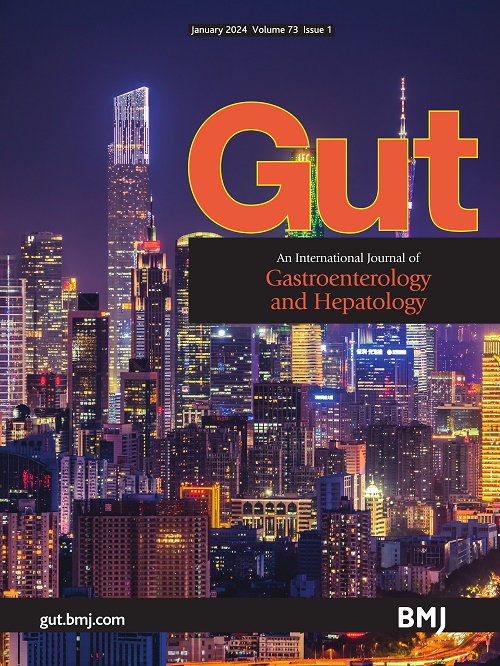CAF-macrophage crosstalk fuels immunotherapy resistance
IF 25.8
1区 医学
Q1 GASTROENTEROLOGY & HEPATOLOGY
引用次数: 0
Abstract
Gastric cancer peritoneal metastasis (GCPM) remains a formidable clinical challenge, characterised by poor prognosis and limited therapeutic options. Despite the transformative impact of immune checkpoint blockade (ICB) therapy across various cancer types, its efficacy in GCPM remains restricted, primarily due to profoundly immunosuppressive mechanisms within the tumour microenvironment (TME).1 2 Li et al recently conducted a single-cell transcriptomic analysis of tumour samples from a phase II trial evaluating ICB (sintilimab) combined with chemotherapy in patients with GCPM.2 Their study established a comprehensive single-cell transcriptional atlas, revealing a novel mechanism driving ICB resistance.2 They identified a unique stroma–myeloid niche dominated by THBS2+ matrix cancer-associated fibroblasts (mCAFs) and SPP1+ tumour-associated macrophages (TAMs), within resistant tumours, forming an immunosuppressive hub mediated via complement signalling.2 Specifically, THBS2+ mCAFs secreted complement component C3, engaging its receptor, C3aR (encoded by C3AR1 ) on macrophages. This C3–C3aR signalling drove the recruitment of peritoneal cavity-resident macrophages and their differentiation into SPP1+ TAMs within the tumour niche.2 These infiltrating SPP1+ TAMs correlated with local T cell dysfunction and low natural killer (NK) cell infiltration. Notably, disrupting the CAF-TAM axis in vivo using a C3aR antagonist (SB290157) increased CD8+ T cell infiltration and significantly enhanced anti-programmed cell death protein-1 (PD-1) responses compared with anti-PD-1 alone.2 These findings provide proof of concept that targeting the complement-driven CAF-macrophage crosstalk can remodel the TME and overcome ICB resistance. The insights from Li et al align with the broader understanding that successful immunotherapy often hinges on the state of the TME, with CAFs and TAMs as principal architects of immunosuppressive or immune-excluded environments. Beyond gastric cancer, numerous studies have …巨噬细胞串扰促进免疫治疗抵抗
胃癌腹膜转移(GCPM)仍然是一个巨大的临床挑战,其特点是预后差,治疗方案有限。尽管免疫检查点阻断(ICB)疗法对各种类型的癌症具有变革性影响,但其对GCPM的疗效仍然有限,主要是由于肿瘤微环境(TME)内的深度免疫抑制机制。Li等人最近对一项评估ICB (sintilimab)联合化疗治疗gcpm患者的II期试验的肿瘤样本进行了单细胞转录组学分析。他们的研究建立了一个全面的单细胞转录图谱,揭示了驱动ICB耐药的新机制他们发现了一个独特的基质-髓系生态位,由THBS2+基质癌症相关成纤维细胞(mCAFs)和SPP1+肿瘤相关巨噬细胞(tam)主导,在耐药肿瘤中形成一个通过补体信号介导的免疫抑制中枢具体来说,THBS2+ mCAFs分泌补体成分C3,与巨噬细胞上的受体C3aR(由C3AR1编码)结合。这种C3-C3aR信号驱动腹腔巨噬细胞的募集,并在肿瘤壁龛内分化为SPP1+ tam这些浸润的SPP1+ tam与局部T细胞功能障碍和低自然杀伤(NK)细胞浸润相关。值得注意的是,与单独使用抗PD-1相比,使用C3aR拮抗剂(SB290157)在体内破坏CAF-TAM轴可增加CD8+ T细胞浸润,并显著增强抗程序性细胞死亡蛋白-1 (PD-1)应答这些发现证明了靶向补体驱动的caf -巨噬细胞串扰可以重塑TME并克服ICB抗性的概念。Li等人的见解与更广泛的理解一致,即成功的免疫治疗通常取决于TME的状态,而CAFs和tam是免疫抑制或免疫排斥环境的主要构建者。除了胃癌,许多研究发现……
本文章由计算机程序翻译,如有差异,请以英文原文为准。
求助全文
约1分钟内获得全文
求助全文
来源期刊

Gut
医学-胃肠肝病学
CiteScore
45.70
自引率
2.40%
发文量
284
审稿时长
1.5 months
期刊介绍:
Gut is a renowned international journal specializing in gastroenterology and hepatology, known for its high-quality clinical research covering the alimentary tract, liver, biliary tree, and pancreas. It offers authoritative and current coverage across all aspects of gastroenterology and hepatology, featuring articles on emerging disease mechanisms and innovative diagnostic and therapeutic approaches authored by leading experts.
As the flagship journal of BMJ's gastroenterology portfolio, Gut is accompanied by two companion journals: Frontline Gastroenterology, focusing on education and practice-oriented papers, and BMJ Open Gastroenterology for open access original research.
 求助内容:
求助内容: 应助结果提醒方式:
应助结果提醒方式:


